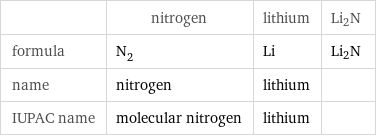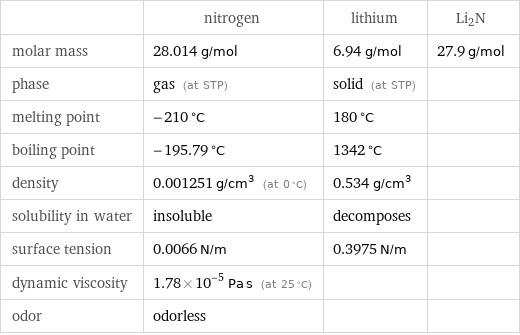Input interpretation

N_2 nitrogen + Li lithium ⟶ Li2N
Balanced equation

Balance the chemical equation algebraically: N_2 + Li ⟶ Li2N Add stoichiometric coefficients, c_i, to the reactants and products: c_1 N_2 + c_2 Li ⟶ c_3 Li2N Set the number of atoms in the reactants equal to the number of atoms in the products for N and Li: N: | 2 c_1 = c_3 Li: | c_2 = 2 c_3 Since the coefficients are relative quantities and underdetermined, choose a coefficient to set arbitrarily. To keep the coefficients small, the arbitrary value is ordinarily one. For instance, set c_1 = 1 and solve the system of equations for the remaining coefficients: c_1 = 1 c_2 = 4 c_3 = 2 Substitute the coefficients into the chemical reaction to obtain the balanced equation: Answer: | | N_2 + 4 Li ⟶ 2 Li2N
Structures

+ ⟶ Li2N
Names

nitrogen + lithium ⟶ Li2N
Equilibrium constant
![Construct the equilibrium constant, K, expression for: N_2 + Li ⟶ Li2N Plan: • Balance the chemical equation. • Determine the stoichiometric numbers. • Assemble the activity expression for each chemical species. • Use the activity expressions to build the equilibrium constant expression. Write the balanced chemical equation: N_2 + 4 Li ⟶ 2 Li2N Assign stoichiometric numbers, ν_i, using the stoichiometric coefficients, c_i, from the balanced chemical equation in the following manner: ν_i = -c_i for reactants and ν_i = c_i for products: chemical species | c_i | ν_i N_2 | 1 | -1 Li | 4 | -4 Li2N | 2 | 2 Assemble the activity expressions accounting for the state of matter and ν_i: chemical species | c_i | ν_i | activity expression N_2 | 1 | -1 | ([N2])^(-1) Li | 4 | -4 | ([Li])^(-4) Li2N | 2 | 2 | ([Li2N])^2 The equilibrium constant symbol in the concentration basis is: K_c Mulitply the activity expressions to arrive at the K_c expression: Answer: | | K_c = ([N2])^(-1) ([Li])^(-4) ([Li2N])^2 = ([Li2N])^2/([N2] ([Li])^4)](../image_source/9937d24116feecfa020b4841f7c08bca.png)
Construct the equilibrium constant, K, expression for: N_2 + Li ⟶ Li2N Plan: • Balance the chemical equation. • Determine the stoichiometric numbers. • Assemble the activity expression for each chemical species. • Use the activity expressions to build the equilibrium constant expression. Write the balanced chemical equation: N_2 + 4 Li ⟶ 2 Li2N Assign stoichiometric numbers, ν_i, using the stoichiometric coefficients, c_i, from the balanced chemical equation in the following manner: ν_i = -c_i for reactants and ν_i = c_i for products: chemical species | c_i | ν_i N_2 | 1 | -1 Li | 4 | -4 Li2N | 2 | 2 Assemble the activity expressions accounting for the state of matter and ν_i: chemical species | c_i | ν_i | activity expression N_2 | 1 | -1 | ([N2])^(-1) Li | 4 | -4 | ([Li])^(-4) Li2N | 2 | 2 | ([Li2N])^2 The equilibrium constant symbol in the concentration basis is: K_c Mulitply the activity expressions to arrive at the K_c expression: Answer: | | K_c = ([N2])^(-1) ([Li])^(-4) ([Li2N])^2 = ([Li2N])^2/([N2] ([Li])^4)
Rate of reaction
![Construct the rate of reaction expression for: N_2 + Li ⟶ Li2N Plan: • Balance the chemical equation. • Determine the stoichiometric numbers. • Assemble the rate term for each chemical species. • Write the rate of reaction expression. Write the balanced chemical equation: N_2 + 4 Li ⟶ 2 Li2N Assign stoichiometric numbers, ν_i, using the stoichiometric coefficients, c_i, from the balanced chemical equation in the following manner: ν_i = -c_i for reactants and ν_i = c_i for products: chemical species | c_i | ν_i N_2 | 1 | -1 Li | 4 | -4 Li2N | 2 | 2 The rate term for each chemical species, B_i, is 1/ν_i(Δ[B_i])/(Δt) where [B_i] is the amount concentration and t is time: chemical species | c_i | ν_i | rate term N_2 | 1 | -1 | -(Δ[N2])/(Δt) Li | 4 | -4 | -1/4 (Δ[Li])/(Δt) Li2N | 2 | 2 | 1/2 (Δ[Li2N])/(Δt) (for infinitesimal rate of change, replace Δ with d) Set the rate terms equal to each other to arrive at the rate expression: Answer: | | rate = -(Δ[N2])/(Δt) = -1/4 (Δ[Li])/(Δt) = 1/2 (Δ[Li2N])/(Δt) (assuming constant volume and no accumulation of intermediates or side products)](../image_source/4584dee9399f222b750feedf58fb6d92.png)
Construct the rate of reaction expression for: N_2 + Li ⟶ Li2N Plan: • Balance the chemical equation. • Determine the stoichiometric numbers. • Assemble the rate term for each chemical species. • Write the rate of reaction expression. Write the balanced chemical equation: N_2 + 4 Li ⟶ 2 Li2N Assign stoichiometric numbers, ν_i, using the stoichiometric coefficients, c_i, from the balanced chemical equation in the following manner: ν_i = -c_i for reactants and ν_i = c_i for products: chemical species | c_i | ν_i N_2 | 1 | -1 Li | 4 | -4 Li2N | 2 | 2 The rate term for each chemical species, B_i, is 1/ν_i(Δ[B_i])/(Δt) where [B_i] is the amount concentration and t is time: chemical species | c_i | ν_i | rate term N_2 | 1 | -1 | -(Δ[N2])/(Δt) Li | 4 | -4 | -1/4 (Δ[Li])/(Δt) Li2N | 2 | 2 | 1/2 (Δ[Li2N])/(Δt) (for infinitesimal rate of change, replace Δ with d) Set the rate terms equal to each other to arrive at the rate expression: Answer: | | rate = -(Δ[N2])/(Δt) = -1/4 (Δ[Li])/(Δt) = 1/2 (Δ[Li2N])/(Δt) (assuming constant volume and no accumulation of intermediates or side products)
Chemical names and formulas

| nitrogen | lithium | Li2N formula | N_2 | Li | Li2N name | nitrogen | lithium | IUPAC name | molecular nitrogen | lithium |
Substance properties

| nitrogen | lithium | Li2N molar mass | 28.014 g/mol | 6.94 g/mol | 27.9 g/mol phase | gas (at STP) | solid (at STP) | melting point | -210 °C | 180 °C | boiling point | -195.79 °C | 1342 °C | density | 0.001251 g/cm^3 (at 0 °C) | 0.534 g/cm^3 | solubility in water | insoluble | decomposes | surface tension | 0.0066 N/m | 0.3975 N/m | dynamic viscosity | 1.78×10^-5 Pa s (at 25 °C) | | odor | odorless | |
Units
